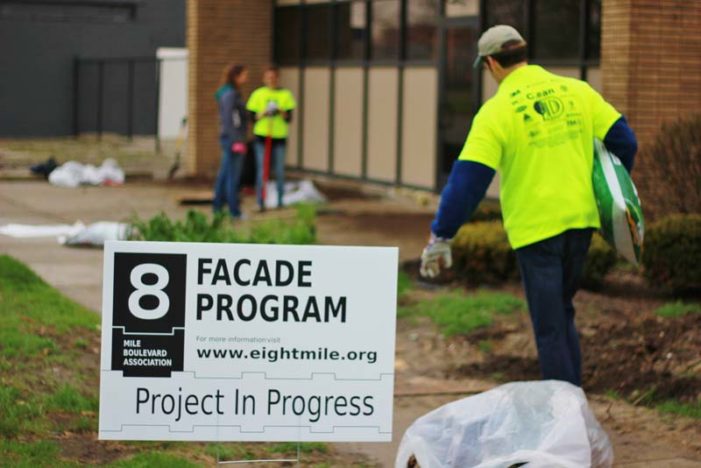A transformative movement is underway along Detroit’s Eight Mile corridor, where imaginative civic organizations, block clubs and neighbors are working side-by-side to restore its neighborhoods.
What began with the work of a few has mushroomed into commitment of many. Rooted on improving neighborhood life, an army of neighbors have united to plant an urban garden here and restore a park. In the process, they have developed an uncommon sense of community.

At the intersection of Eight Mile and I-75 sits Knudsen Park. It was forgotten for years … grass almost five feet tall, broken swings and a haven for wild dogs. Jordan Twardy, executive director of the Eight Mile Boulevard Association, saw the need and applied for a grant from Tom’s of Maine, a natural personal care products company that funds grassroots projects. Although he was rejected the first time, he received a grant last year. Coupled with funds from the city of Detroit, it totaled $75,000.
Thanks to that collaboration, plus a host of contractors working together, this Eight Mile gateway park into the city has new swing sets, a tire swing, play car and recycled park benches. It will soon have a walking path, rehabilitated basketball court, grills and picnic tables, trees, signage, fencing and a human-scale sun dial.
“Where capacity ends, a handshake begins,” says Twardy. “That jump started Knudsen Park.”
Over on Evergreen, just one block south of Eight Mile Road, sits O’Hair, the largest city park in Detroit. Residents want the park, which is surrounded by homes, cleaned up. The Eight Mile Boulevard Association reached out to the O’Hair Park Community Association about coordinating a cleanup project. In addition, a $5,000 commitment from Mercedes-Benz Financial Services (MBFS) helped enhance the park’s amenities.
Volunteers from MBFS, Motor City Grounds Crew, Corpus Christi Church and countless local neighbors cleared the wilderness, removed two derelict vehicles and laid a path of woodchips to create a walkable place. DTE Energy provided the wood chips. The Detroit Public Works Department hauled away the debris. The Detroit Police Department coordinated the removal of the abandoned vehicles.
The O’Hair Park Community Association adopted the park and cooperates with the city to maintain it. Together with the Eight Mile Boulevard Association, it has developed partnership opportunities to keep this section of Detroit vibrant and a place where neighbors look out for each other. It all started with a park.
While some neighborhoods revitalize parks, others plant gardens. The Binder Street Block Club added the Farwell Community Garden to its list of projects to transform the neighborhood. The club covers just three blocks, but those three blocks are powerful. That power is amplified by collaboration with Twardy’s Eight Mile Boulevard Association. As part of its Clean the D project, the association sent kids over to help with planting and harvesting.

“We have been fortunate to have the Eight Mile Boulevard Association supporting us for a second year, says Elois Moore, president of the Binder Street Block Club. “Without their commitment and support, we would have not been successful in supplying produce to the community.”
Other block clubs, including the Yonka-Norwood Block Club and the Fenelon-Conley-Keystone Block Club, are involved in the project as well.
In addition, Moore went on Fox 2 in Detroit to talk about the need for rain barrels, the only source of water for the garden. The University of Michigan stepped forward with $1,000 to buy two 275 gallon barrels.
The Farwell Community Garden grows pesticide-free healthy fruits and vegetables, from horseradish to cantaloupes, for the community. Moore also hopes to introduce a program to help neighborhood kids learn about gardening.
The club is also busy with other projects. Once a month it meets and boards up blighted homes in the neighborhood. A $5,000 grant from U-M helped Moore launch a walking program in the neighborhood. About 40 people participate. One woman even found a boyfriend.
“We must equip the neighborhoods to stand on their own,” Twardy says. “Not all neighborhoods have a Dan Gilbert. It is beautiful if you have billions. If you don’t, it is a little more involved.”
He makes this analogy: “In a natural disaster, rescuers first look for signs of life and help pull survivors out. We must show signs of life and offer solutions to get the dollars we need. To do that, we must empower neighborhoods to ownership.”
It’s time to dig in Detroit.



Very good and wonderful and very important also an blog Thanks